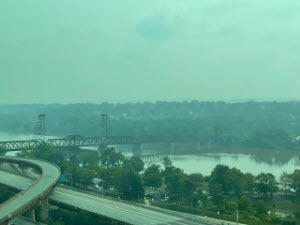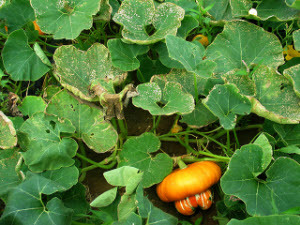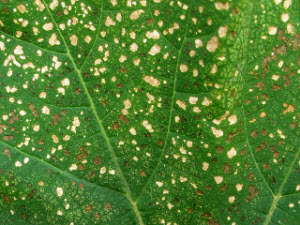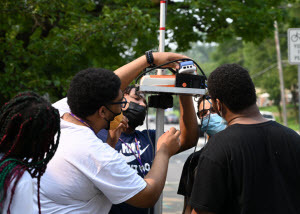Smoky Skies and Plant Health - Air Mail!
The New York State Department of Environmental Conservation sent this bulletin on 08/20/2021 11:34 AM EDT |
| DEC Delivers - Information to keep you connected and informed from the NYS Department of Environmental Conservation |
| Share or view as a web page || Update preferences or unsubscribe |
This Month's Topics: |
Public & Stakeholder Participation Information:
Air Mail! is the publication to announce public and stakeholder information about air quality topics. All NYS residents are environmental stakeholders – we welcome anyone to join the information sessions and other opportunities posted here. Smoky Summer SkiesOn July 20, 2021, NYS issued its first statewide air quality health advisory for fine particulate matter in at least a decade. Wildfire smoke blowing in from fires out-of-state caused hazy skies, red sunsets, and poor air quality across the Northeast. Most of the smoke likely originated from fires in Canada, just north of Minnesota, then was carried southeast through the Great Lakes by northwesterly winds. The smoky skies created hazy conditions that captured the attention of people all over the state and reduced visibility to as low as 2.5 miles Wildfire smoke traveling far across the country has been somewhat of a common occurrence in recent summers. Smoke from large western fires often blows east, but it typically moves at high altitudes where it goes unnoticed by people on the ground. By the time it reaches NYS, the smoke has had time to disperse and is usually traveling over 3 miles above our heads. However, according to data from NASA, a significant portion of the smoke in July traveled close to the ground instead. This meant that even though NYS was far from the source, the smoke at ground level was still in high enough concentrations to cause spikes at air monitoring stations across the state. In the NYC Metro Area, these spikes even reached the level of “Unhealthy,” which is when everyone is at risk of experiencing health effects. Wildfire smoke contains a wide variety of unhealthy pollutants, including fine particulate matter (PM2.5) and carbon monoxide. At high concentrations, inhaling smoke can reduce lung function, worsen asthma, and even lead to premature death in people with heart or lung disease. High concentrations of these types of pollutants are what recently led DEC to determine the air quality was unhealthy for sensitive groups statewide. People with preexisting conditions, young children, and the elderly were at elevated risk.
Photo Caption: Hazy skies reduced visibility to between four and five miles in Albany, NY. This photo was taken on July 20, 2021, in downtown Albany facing the Hudson River and Corning Preserve. Photo Credit: Ona Papageorgiou, NYSDEC Graphic Caption: For the first time in at least ten years, the AQI forecast map on July 20, 2021, predicted every region in NYS to have PM2.5 at levels considered unhealthy for sensitive groups. Ground Level Ozone, More than Just a Human Health Risk
Earlier this year, ozone damage to cucurbit crops (cucumbers, squash, zucchini, and their relatives) was reported on Long Island and in our neighboring state of Connecticut. The ozone affected cucumbers the most and appeared as white spotting and yellowing on the leaves. Some of the damaged leaves will die. This damage can slow growth, reduce fruit production, and even kill the plant in severe cases. Ozone damage can appear similar to many other types of plant damage. For help telling the difference, check out this database of vegetable damage photos. In addition to a huge variety of cultivated plants, ozone can also damage wild species. This can result in reduced biodiversity, changes to habitat, or even changes to water and nutrient cycles. Learn what you can do to help protect our environment, crops, and ourselves from air pollution. Also, be sure to check the AQI forecast daily, or sign up for air quality alerts with DEC Delivers so you can stay aware of your air. Photo Captions: Top, A Turk’s Turban squash plant damaged by ozone. This damage could impact the amount of squash produced by the plant. Bottom, A close-up of a damaged squash leaf. Ozone has killed the parts of the leaf that are now white and brown spots. Photos were taken by a contributor on Long Island. Article Contributor: Margaret McGrath, Ph.D., Cornell Cooperative Extension. Taking a STEP Toward our Future in Air MonitoringDEC’s Division of Air Resources continues its support of the University at Albany Science and Technology Entry Program (STEP) this summer. For the fifth year, staff from DEC’s Emissions Measurement Research Group showed students how to conduct air monitoring research. Environmental Justice was a central theme of discussion as STEP students learned about near roadway air monitoring by taking air quality measurements in the South End of Albany and around the University at Albany campus. In addition, a workshop for Academic Career Exploration (ACE) students included presentations by DEC environmental educators to inspire students to get outdoors and think about future environmental careers. Denine Jackson, an assistant engineer in DEC’s Division of Water, Buffalo, spoke to the students about her experiences in obtaining an education in STEM (Science, Technology, Engineering, and Math) Since 1986, STEP has been promoting diversity, equity, and inclusion of underrepresented students in science and engineering education. Increasing diversity in STEM career paths is essential to ensure equal representation in problem-solving and decision making, especially as we develop policies and mitigation strategies to address climate change. Perhaps some of the students will decide to join the DEC team after they graduate and help tackle future environmental issues. Photo Caption: University of Albany STEP students setting up air quality monitoring equipment. Helpful Links:
Dates to Remember:
Stay Informed about Your Air QualityNYS' ozone season runs from April through September. DEC publishes ground-level ozone forecasts during ozone season and particulate matter pollution forecasts year-round using a scale called the Air Quality Index (AQI). DEC sends out an air quality alert when there is a high AQI value, which indicates polluted air. Individuals with pre-existing respiratory or cardiovascular conditions and people who exercise outdoors should take caution during an air quality alert. Find out if an Air Quality Alert is in effect by calling the toll-free Ozone Hotline: 1-800-535-1345. The AQI can be accessed in three ways:
Connect with us at Air Mail!Did you enjoy reading this issue? Perhaps your friends and family would too. Share Air Mail! by using the “Share” button below. If you would like to receive Air Mail! in your own email box, sign up now! We would also like to know what you think. Send your Air Mail! questions and comments to the Team at DAR.web@dec.ny.gov. |


 in some places.
in some places. While the smoke in July was caused by out-of-state wildfires, fires within NYS cause local air quality issues every year. Although some of these fires occur naturally, according to DECs Forest Rangers, 95% are caused by humans. Before starting any kind of outdoor fire, check the fire danger map for your area and read up on NYS open-burning rules. Also, be sure to check your local AQI forecast every day, so you can be aware of your air!
While the smoke in July was caused by out-of-state wildfires, fires within NYS cause local air quality issues every year. Although some of these fires occur naturally, according to DECs Forest Rangers, 95% are caused by humans. Before starting any kind of outdoor fire, check the fire danger map for your area and read up on NYS open-burning rules. Also, be sure to check your local AQI forecast every day, so you can be aware of your air!

 and her career path.
and her career path.